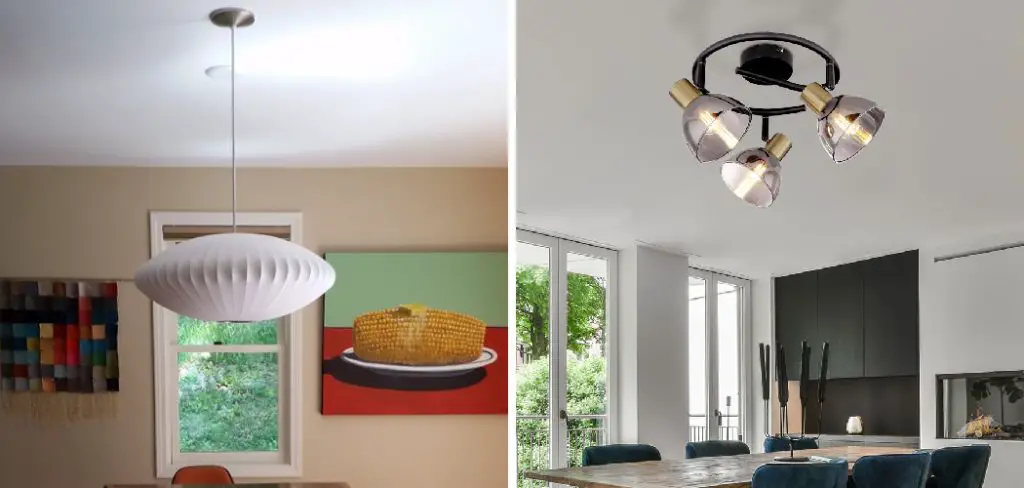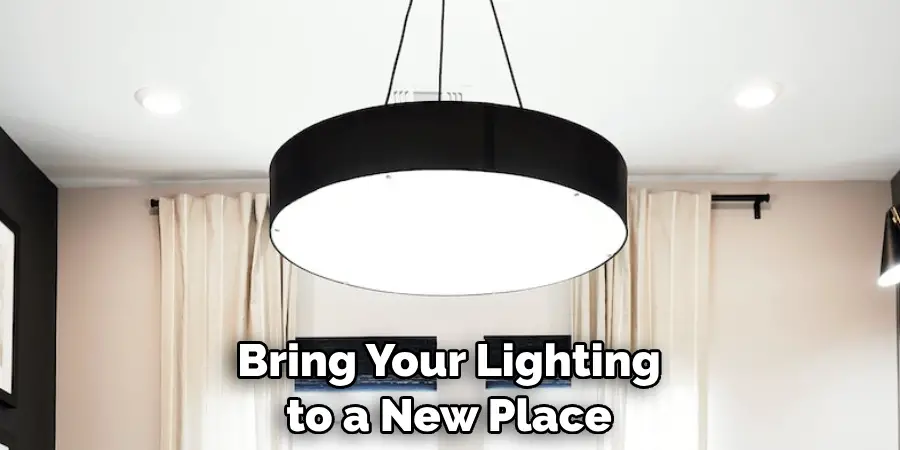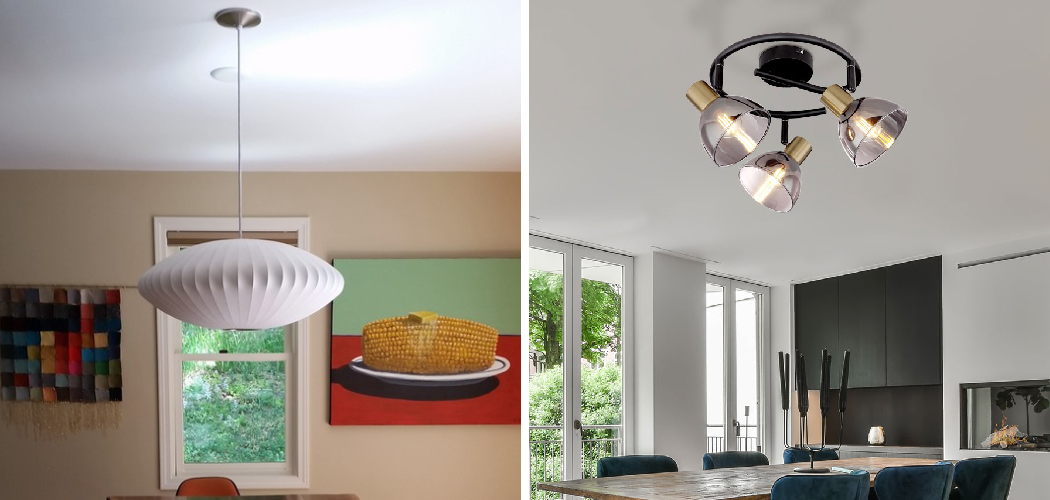Moving to a new home or renovating your house can be exciting, but it can also mean dealing with some unwanted challenges. One of which is sometimes having to move a ceiling light fixture.

It may seem intimidating, but with the right tools and instructions, you can do it yourself without the help of an electrician. In this blog post, we’ll guide you through the process of how to move ceiling light fixture like a pro.
Can You Move the Ceiling Light Fixture?
Are you tired of the unflattering lighting in your home? Do you wish you had the ability to move your ceiling light fixture to brighten up a different area of the room? Well, we have good news – it is possible! While it may seem like a daunting task, moving a ceiling light fixture is actually a doable DIY home improvement project.
However, it does require knowledge of electrical wiring and careful attention to safety precautions. With a little research, proper tools, and patience, you can transform the lighting in your space and create a more welcoming and cozy atmosphere. So take the leap and move that ceiling light fixture – your eyes (and your mood) will thank you.
Why Should You Move the Ceiling Light Fixture?
Are you tired of the dull and uninspiring lighting in your living room or bedroom? If so, it may be time to consider moving your ceiling light fixture. Not only can changing the location of your lighting create a more visually appealing and interesting space, but it can also provide greater functionality and practicality.
Moving your light fixture to a new spot allows you to illuminate key areas of your room more effectively, highlight decorative features, and even create a more welcoming ambiance.
Plus, with modern LED lights and other energy-efficient options, you can reduce your energy consumption and save on your electricity bills in the long run. So why not take the leap and see how moving your ceiling light fixture can transform your space?
How to Move Ceiling Light Fixture Without Calling in an Electrician
1. Turn Off the Power and Gather Materials.
Before starting the process, make sure to turn off the power to the light fixture at the circuit breaker box. Then, gather the necessary tools, such as a screwdriver, wire connectors, and a voltage tester. You may also need a ladder, a drill, and new electrical boxes and wires if moving the fixture to a new location.

2. Remove the Light Fixture
First, remove the light bulb and any lampshades or covers. Then, take down the ceiling fixture by unscrewing any screws or bolts that secure it to the ceiling. Be careful not to damage the wires and keep them attached to the fixture.
3. Disconnect the Wiring
Once the fixture is removed, you’ll see the wires connected to it. Use a voltage tester to ensure there’s no power running through them. Then, unscrew the wire connectors and separate the wires. If you’re moving the fixture to a new location, you may need to extend the wires or use new ones.
4. Wire the New Electrical Box
If you’re moving the fixture to a new location, you’ll need to wire a new electrical box to connect the wires. Use a drill to make a hole in the new location and secure the box to the ceiling. Then, strip the ends of the wires and connect them to the wires in the box using wire connectors.
5. Install the New Fixture
With the wiring complete, you can now install the new fixture in its new location. Follow the manufacturer’s instructions and use the screws or bolts to secure it to the ceiling. Once the fixture is in place, attach the lampshades or covers and screw in the light bulb.
6. Test for safety.
Once everything is in place, use the voltage tester to make sure there’s no power running through the wires before flipping the switch and testing the lights. If all goes well, your new ceiling light fixture should be good to go!
7. Seal It Up
To ensure that your new installation stays safe and secure, apply some caulk or sealant around the electrical box and fixture. This will keep out any moisture or dirt so that your ceiling light remains in perfect working order.
That’s it! You’ve now learned how to move ceiling light fixture. With the proper safety precautions, tools, and knowledge, you can now bring your lighting to a new place in your home or office. If you’re ever in doubt about whether or not you should attempt this project yourself, be sure to contact an electrician for help.

5 Considerations Things When You Need to Move Ceiling Light Fixture
When you need to move a ceiling light fixture, there are several considerations that must be taken into account. Here are five important things to keep in mind:
1. Safety
Make sure the power is turned off before starting any work. Wear protective eyewear and gloves when working with electrical fixtures, and use caution when moving around or on a ladder.
2. Weight
Smaller fixtures are typically easier to move than heavier ones, and will require less effort during installation. Make sure the material you use for mounting is strong enough to support the weight of your fixture.
3. Location
Plan ahead when selecting the position of your light fixture. Place it in an area where it won’t be too close to furniture or objects that may come into contact with it.
4. Wiring
Consider the existing wiring in your house when moving a light fixture. If you are connecting to new wiring, make sure it is up to building codes and meets all safety requirements.
5. Accessibility
If the fixture needs to be removed for maintenance or repairs, select a position that is easily accessible. You will want to be able to reach the light fixture without having to use a ladder or other equipment.
These five considerations are important when moving ceiling light fixtures. Make sure you take the time to plan ahead and consider all of these factors before making any changes. Doing so will help ensure your safety and provide you with better results. Good luck!
5 Benefits of Move Ceiling Light Fixture
When you move your ceiling light fixture, there are several benefits that come with it. Here are five of the most common advantages that come with making this change:
1. Design
Moving the light fixture allows you to customize the look and feel of a room in ways that cannot be achieved with just furniture and decor. You can create interesting patterns and shapes that add drama to a room by varying heights and distances between fixtures.

2. Lighting
Moving the fixture to a different position can drastically change how light is distributed in space. This can be used to increase or decrease illumination and create special lighting effects, such as highlighting certain room features.
3. Energy Efficiency
By carefully selecting your light fixture and its placement, you can save on energy costs over time. The correct type and size of fixture can help to reduce electricity consumption, as well as provide better illumination with less wattage.
4. Safety
Moving the light fixture away from potential hazards such as furniture or objects can make a room safer and more comfortable for everyone in it. This is especially important if you have small children running around.
5. Maintenance
Moving the light fixture can make it easier to perform regular maintenance and repairs. By having better access to the fixture, you can quickly diagnose any issues that arise without taking down or moving anything else in the room.
Making the decision to move your ceiling light fixtures comes with several benefits. Take them into consideration when making this change so that you can get the best results possible.
Some Common Mistakes People Make When Trying to Move Ceiling Light Fixture
Moving a ceiling light fixture may seem like a simple task, yet it can often turn into a major headache. One of the most common mistakes people make is underestimating the fixture’s weight and not properly securing it before attempting to move it. This can result in the fixture slipping out of their hands or falling from the ceiling, causing significant damage.
Another mistake is not turning off the power before starting the process. This can be dangerous and potentially lead to electrical shocks or worse. Lastly, not having the proper tools or equipment can make the job much more difficult and increase the risk of injury. Taking the necessary precautions and being prepared can make moving a ceiling light fixture a successful and stress-free experience.
Conclusion
Moving a ceiling light fixture can seem daunting, but with a little knowledge and the right tools, you can do it yourself. Always turn off the power, document the wiring, and follow the manufacturer’s instructions.
If you’re unsure about something or don’t feel comfortable, it’s okay to call in a professional electrician. Thanks for reading our post about how to move ceiling light fixture.

